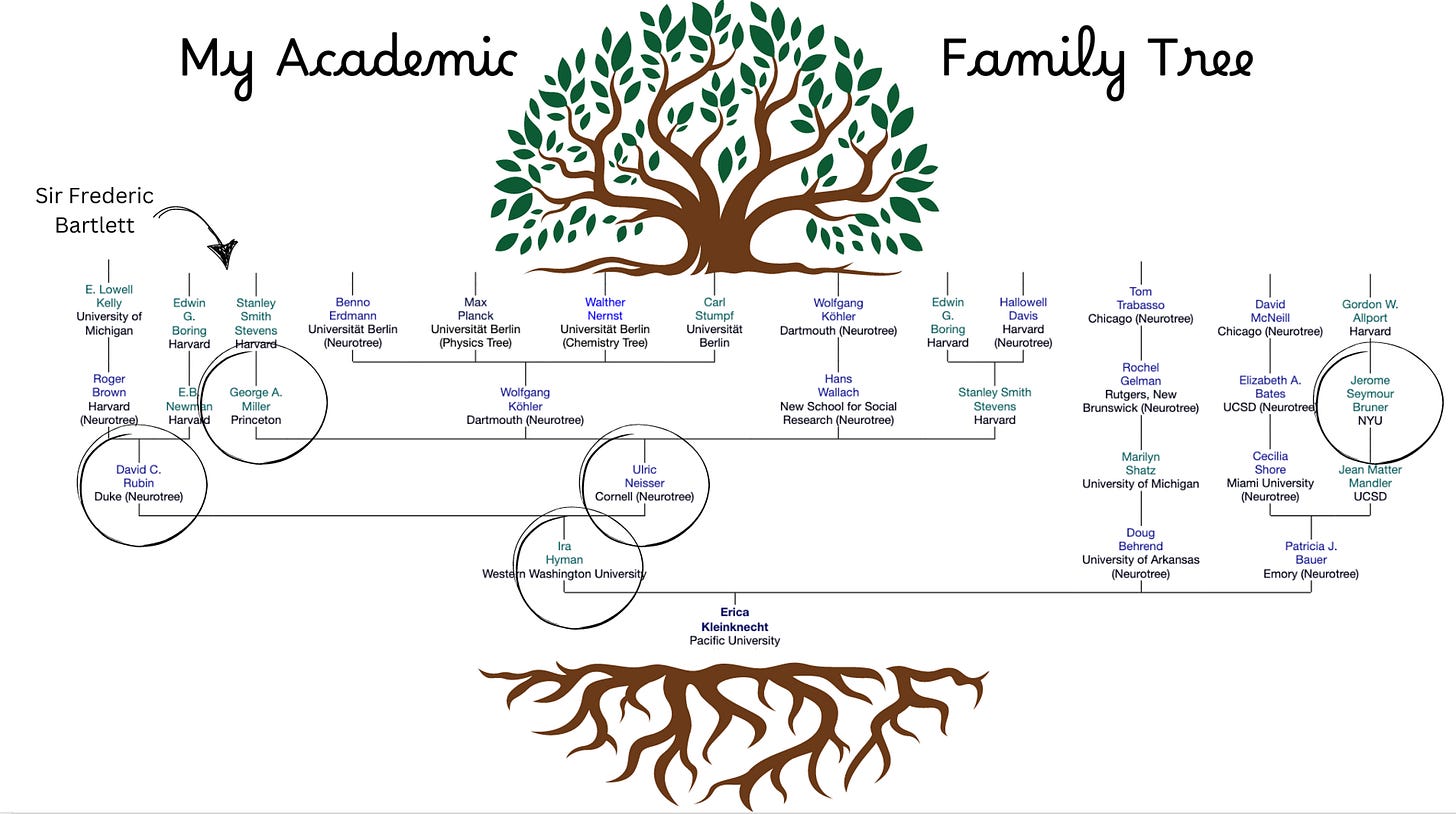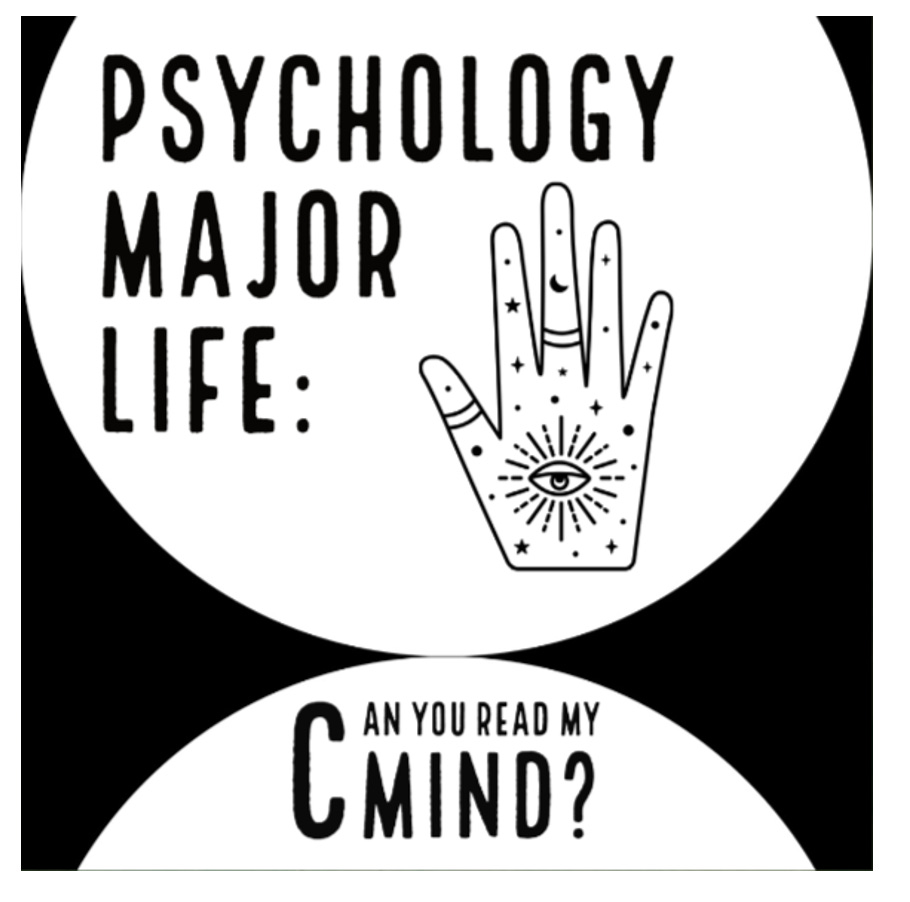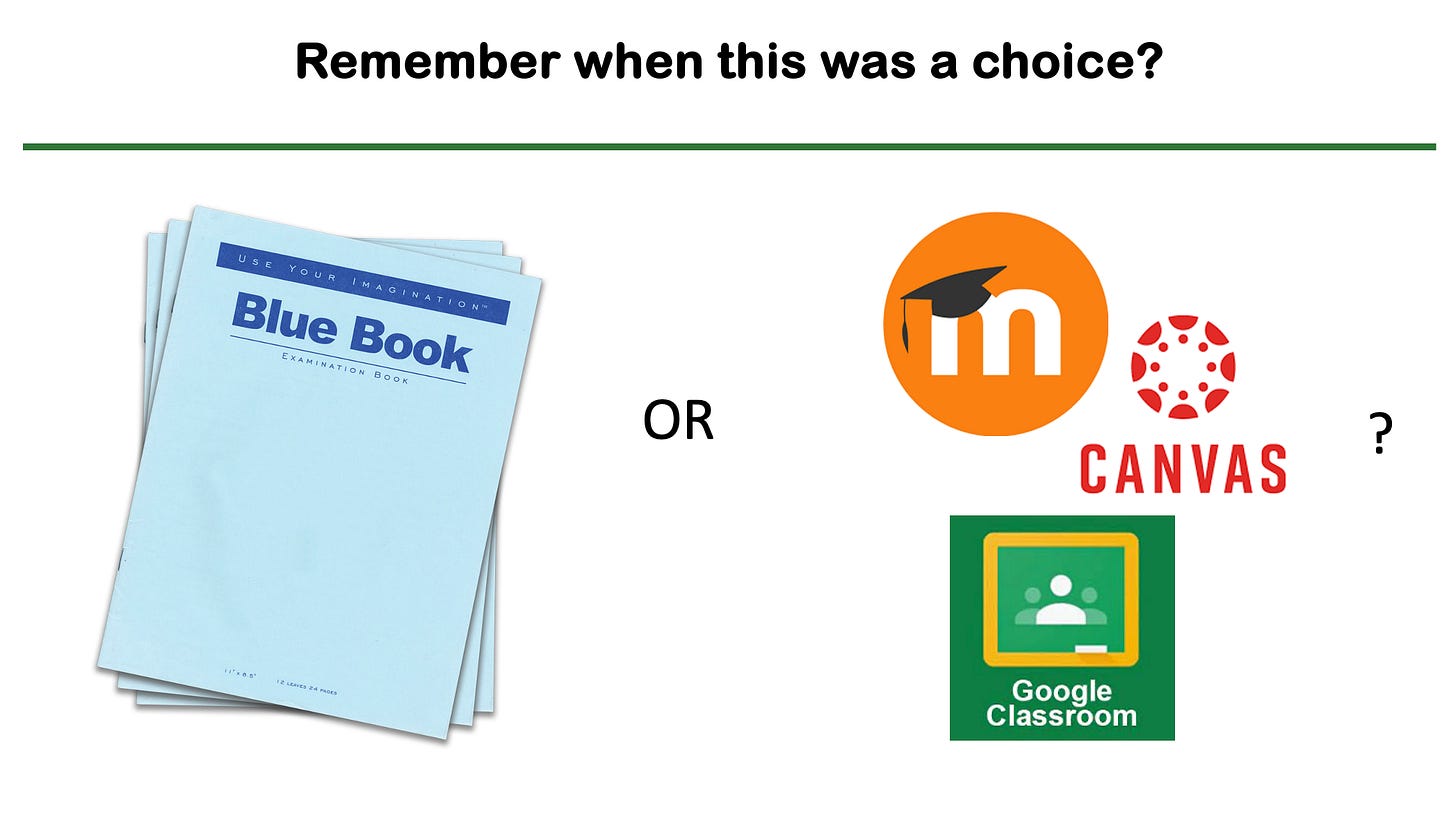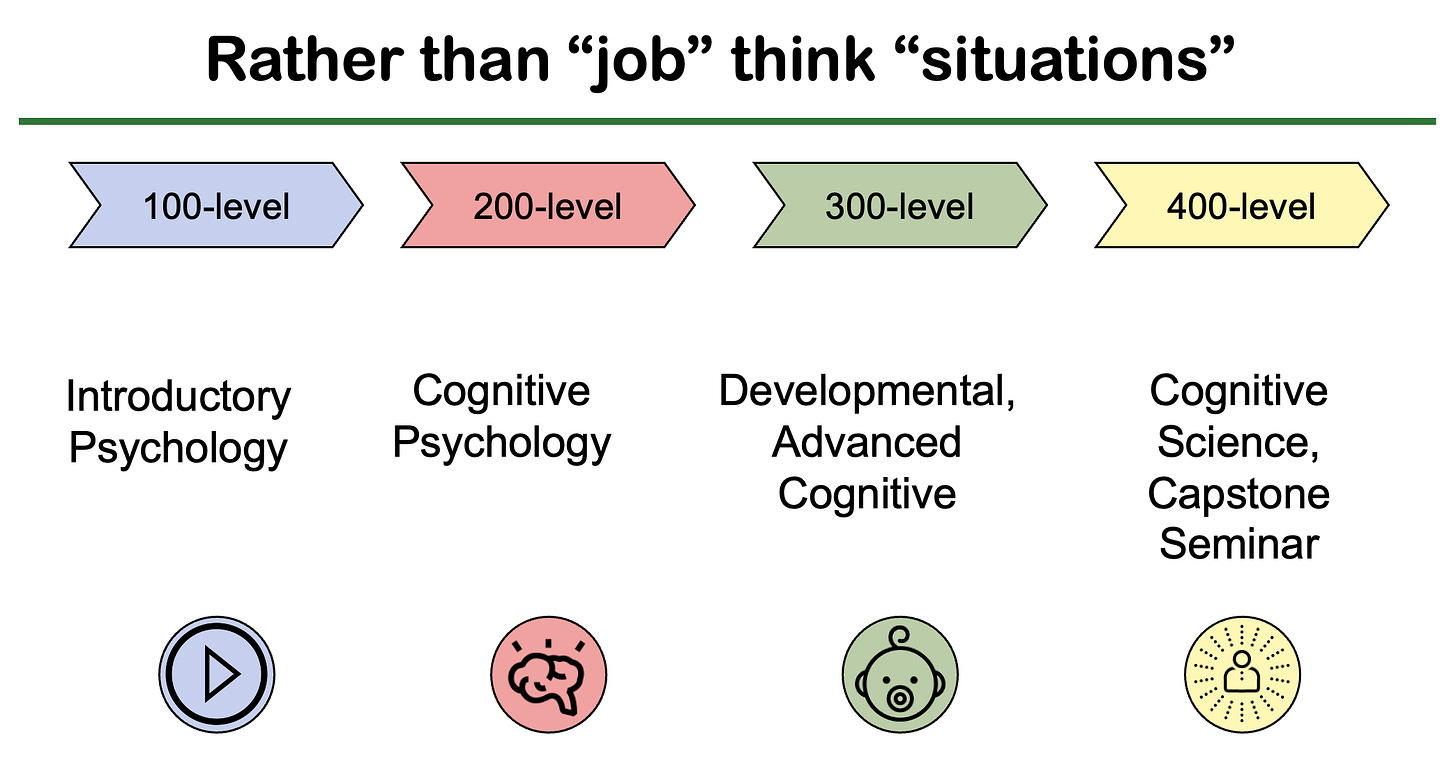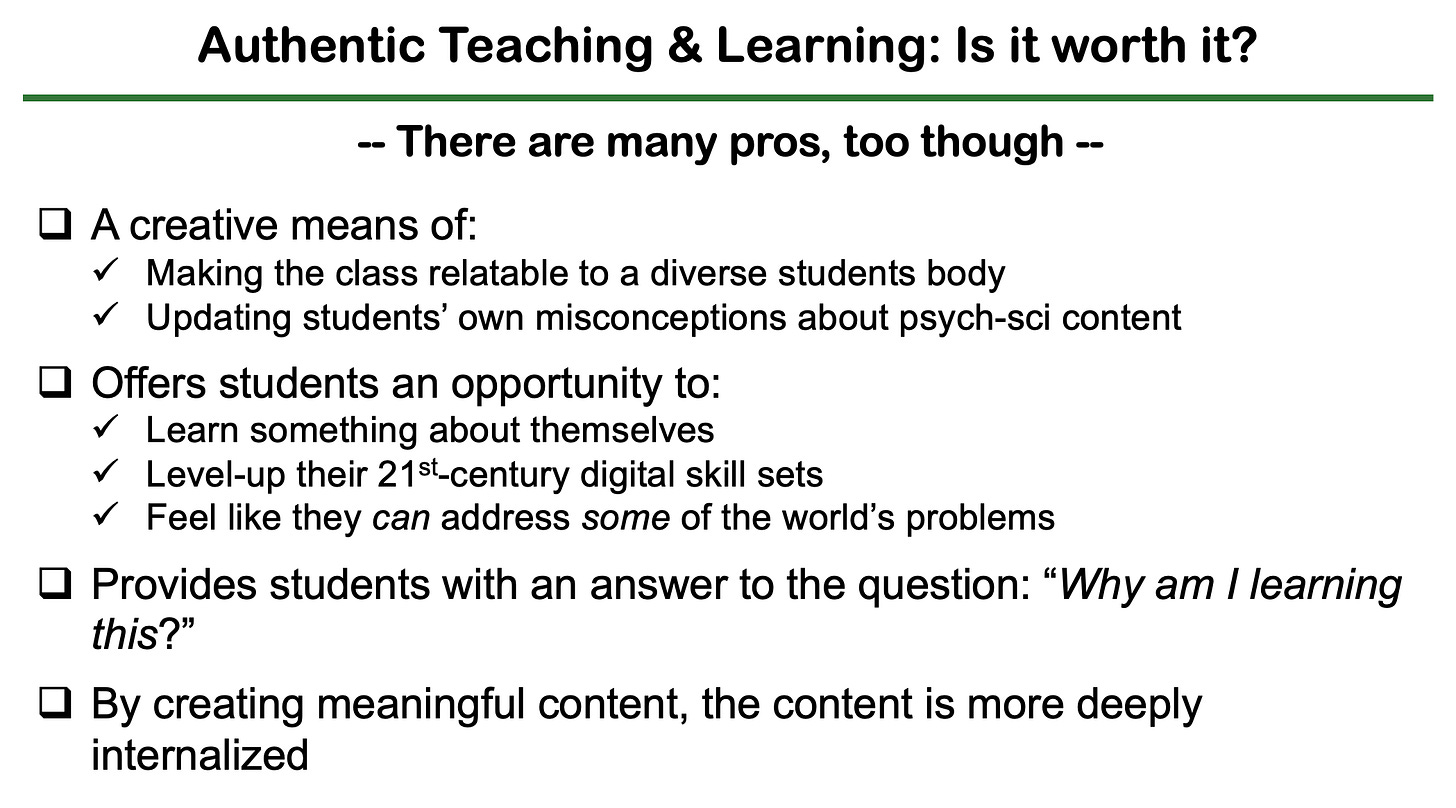Trade Tools: The World has Problems and Psychology has Solutions
Text of an invited address on Authentic Teaching and Learning in the 21st Century
Background
In 2023, I was the recipient of the Western Psychological Association’s “Outstanding Professor of Psychology” award. A fabulous honor, and one that came with responsibility! In April 2024, I made good on the award by delivering an hour-long address about my teaching. The text and select slide screen shots that follow is most of my award address, slightly edited for ease of reading. The text lays out my philosophy and broad vision of what Authentic Teaching can look like, in Psych. In future newsletters I will share further specifics on individual class projects!
Preview, given the long read that follows [turns out I can say a lot in just under an hour]:
The world has problems and Psychology has solutions. Adapting Authentic Teaching and Learning principles to work with undergraduate Psychology curricula offers Psychological Science scholars a means of using our science as it’s intended: to help promote psychological health and wellbeing. While this kind of teaching can be a bit labor intensive, the resounding feedback from students is that the hard work is worth it, because it is so powerful to know that your work can make an impact.
Address begins here:
I’d like to start at the end today, with a preview of the take-home message: My primary learning outcome for students in every class I teach is that they come to realize that, Yes, the World has Problems, and YES -- they can contribute to the solution space for these problems no matter their level of expertise. Whether Intro Psych or Senior Capstone students, they can use what they are learning to begin to effect positive change in the world.
My Academic Family Tree
I come from a long line of Psych-Scientists who emphasized this point: That our reason for being as Psychological Scientists is to discover and deliver: To understand human behavior so we can offer empirically sound solutions that can promote human welfare. You might recognize this sentiment as reflecting George Miller’s 1969 APA address (e.g., his call to Give Psychology Away) and, if you look at the academic family tree graphic, you can also see that Miller is one of my academic “great grandpas” – A point of connection I learned from one of my undergraduate research mentors, Ira Hyman, who often discussed the fact that we should always strive to situate our science in the real-world following principles of ecological validity. Ecological validity is a perspective championed by the likes of Jerome Bruner and Ulrich Neisser – who are also academic grandparents of mine -- such that our research needs to reflect the real world and the complex ecologies that behaviors are situated within.
Science & Society Feedback Loops
My formal studies in Psych Science began in the in the early 1990s at the peak of the “Memory Wars,” a time period in which a serious social issue changed the landscape of memory science. The lessons I learned then about keeping the science & society loop in mind stayed with me as I carried on with my studies and as I have charted my course through my 21-years-and-counting career at Pacific University.
Pictured below a recent class project about the Memory Wars and what we've learned since then about memory malleability and mental health and wellness.
And here’s another science + society loop project, and one that was well timed! I’d designed “The Thinker’s Guide to the Metaverse” before OpenAI’s release of ChatGPT, and so the timing for this class -- Spring 2023 -- was really a beautiful serendipity.
These two projects and more are just previews —
I selected this array of images to feature the scope of projects I interleave into my courses. And that is, of course, the main point of this talk: To share with you the philosophy behind my project-based approach. As I discuss this, I will feature some exemplar outcomes. To do all this, I'd like to take you on a bit of a walk to show you how I have arrived at this point where I am all in on authentic learning projects.
Here’s the highlights of that walk I want to take you on.
21st Century Teaching: Transforming challenges into opportunities
Effort after meaning & the Zoom-U pivot
Authenticity in teaching and learning: What is it?
What does Authenticity look like, in Psych?
Concluding Remarks
We’ll circle back to my class projects like the two I just mentioned. Before I do so, though, I’d like to expand on my teaching philosophy and how my work has changed of late, especially since the advent of the pandemic.
First – let me ask you a question: What do you think? Is the following statement Fact or Fiction?
Digital Natives are “technology naturals”. They are fundamentally different from previous generations, given their immersion in a tech-filled world. They can pick up new technology and run with it and don’t need direct instruction.
The idea that our students are fundamentally different given their immersion in a digital world really doesn’t make sense. Phone apps and games are painstakingly designed to be intuitive. Smart phones are designed to invite exploratory behavior. Anyone can pick up a phone and start poking around with success. When we can’t make the phones work as we want them too – that’s when our skills really show and where older folks do just fine – when they are motivated to figure it out.
21st Century Teaching: Transforming challenges into opportunities
I’ll come back to that digital native idea in a bit. For now, suffice it to say that we are faced with plenty of challenges in our classrooms “these days” – some are not unique to the 21st century, but our modern era puts a new spin on old problems. One new problem is that misinformation is everywhere in social media and young people are spending on average 5 hours a day scrolling through reels, tik-toks and what have you. And they arrive in our classes with a jumble of fact & fiction about psych in their minds. We know that some of what they think about Psych is fiction – but they don’t, often, realize this.
While they know that Psychologists don’t read minds, …
When it comes to other issues – like the impact of Trauma on Memory, or the inherent validity of Learning Styles – they have strongly held beliefs about these issues.
Misinformation about psychological principles is rife in social media, and elsewhere
Sorting out fact from fiction is a delicate matter
Rather than inform, we must change beliefs
Rather than inform, we must instead change beliefs. Changing long held beliefs is a delicate business.
Not all their mistaken beliefs about Psychology come from social media: The APA recently reported that only about half of High School Psych teachers are credentialed to teach it. This is alarming given that Psych is the 5th most frequently taken AP Exam. Given that the AP curriculum is need of an overhaul -- you can begin to see why it’s hard to change beliefs: Students tend to LOVE their High School Psych classes and they are DISMAYED to find that some of what they learned was so far out of date that it could now be deemed incorrect.
Psychology is popular: the APA reports that about a million students a year take an Intro to Psych class.
We have other challenges as well, that also reflect Psychology’s popularity: the students in our classes are diverse in their interests and aspirations – This is the major representation in a recent Intro class of mine – there are 21 majors noted in the graphic. While the representation starts to shrink as the course numbers increase, it is not at all uncommon for me to have students in 300-level / junior level classes representing 6 - 8 different majors, making it so that only about half of the students enrolled in my upper division classes are actually majors.
With this diversity comes students with a variety of post-grad plans and career aspirations as well. What this means is that students enter into our classes not only with diverse “preparation” in terms of the quality of their pre-Psych experiences, but they also arrive with diverse interests and diverse goals. This can make for a challenging classroom dynamic.
We know that in theory a challenge is the inverse of an opportunity but sometimes a reminder doesn’t hurt:
The notion that digital natives don’t need to be taught is false AND – we – GenX and Boomers – can teach our students things about technology. Our lived experiences do equip us with different baselines but the generation one was born into DOES NOT make people fundamentally different when it comes to basic principles of learning, memory, and skill development.
When it comes to the false beliefs many students hold about Psych – we can use our science to update beliefs and to shape new ones. Learning Science, Wise Interventions, and more offer us incredibly useful tools for teaching.
I mentioned diversity in interest and preparation, and of course our students are diverse in many more ways than this! The diversity students bring is a boon, though it may take a little thinking about how to harness it. Don’t be daunted by this.
Our students have diverse post-grad goals which influences their motivations for learning specific content – this diversity may impact some classes more than others, but it’s there. Despite this, our students all have some things in common: They are seeking meaning. AND they all need a 21st century skill boost.
Effort after meaning & the Zoom-U pivot
Students come to Psychology for answers and self-understanding as much as they come for the knowledge and skills that will land them a job or a grad assistantship. “Effort After Meaning” is a longstanding “Psych-Soundbite” from a different era (c 1930s). Bartlett—who, by the way, isn’t officially in my academic family tree but you may have noticed that I added him in because his work was so influential to the subsequent work of my mentors (notably Neisser and Hyman) – Anyway, Bartlett’s Cambridge studies in serial remembering showed a reliable pattern of transformation whether the content his participants experienced and recalled was verbal or visual. As his participants repeatedly recalled the presented content such as Native American folk tales or Egyptian Hieroglyphics, they didn’t just forget details, rather they transformed the material. Unfamiliar terms were replaced with familiar ones, atypical contexts were re-imagined as typical, and images were altered. Participants would add elements too, like adding a moral to a story that did not originally have one. From these observations Bartlett surmised that all of our naturalistic cognitive endeavors are shaped by an effort after meaning.
Some years later Jerome Bruner discussed the human tendency to seek – and make – meaning in his writings on Folk Psychology and the power of narrative too, for example where he stated that “Ongoing meaning making through narrative is one of the crowning achievements of human development”. These 20th-century thinkers (Bartlett, Bruner) have long -guided my thinking about instructional design and what I invite students to do in the service of learning. In every class I’ve ever taught I’ve included an activity that reflected the tendency to seek meaning and that capitalized (in different ways) on the power of narrative. But the pandemic pushed me to new heights in how I applied these ideas in my teaching practice – enough so that I want to talk – reminisce -- about that time a little bit now.
Speaking of the pandemic-pivot: Remember when this (image above) was a choice? OMG. I admit that in the before times I ran a primarily paper-and-pencil classroom. I did use our LMS to post things, and I did require that all formal work be typed (!), but I still did essay exams and in-class activities “by hand.”
For example, in the before times my students were doing some applied activities like the sketch noting project you see pictured. Back then I thought that what I was doing was pretty creative, but really, aside from the meme correction and sketch noting lessons, in all those cases, students were really just writing essays.
The pandemic pivot – and the social justice reckoning that followed in the summer and fall of 2020 -- initiated a pretty seismic shift in my thinking and approach – I realized that there was more that I could be doing in the service of helping students realize that we can, and should, give psychology away. During the pivot period my own digital literacy skills got a significant upgrade too, as did my thinking about what else I could be doing in the service of promoting student learning in my classes.
Authenticity in teaching and learning: What is it?
In one of the pandemic-pivot sessions I attended, the facilitator introduced Authentic Learning Projects as a win-win because they were impactful and easy! Here’s the formula he shared:
Put students in groups
Instruct them to imagine a future work scenario
Have them create a hypothetical “day-in-life” ideal plan for using course content “on-the-job”
Have them present their work on a website so others can see and potentially use it
Best of all, he said is this: Because they are digital natives, you don’t even need to teach them how to build the website! They will figure it out on their own.
My initial reaction to this presenter’s glib presentation was one of skepticism:
While I did know how to make memes and I did know how to work in the WordPress Environment, I wasn’t sure I knew how to make a full-blown website either.
Despite the issues I took with the facilitator, I did see that there was something there. I didn’t see it being easy, but I suspected there was something of value with the incorporation of some Learning Science principles.
Importantly for the time period: (1) The approach was digital, so we could do during Zoom-U, and (2) it appeared to be fun and we all needed a little fun at that time.
When I learned from subsequent Ed-tech training sessions that Google Apps are pretty straightforward to use, I decided to go for it.
During those pivot-period sessions and over the following summer -- I had a few epiphanies. (1) In Sp 2020, the only equitable approach to testing over zoom and under the stressful conditions of the pandemic was to take a mastery approach. I learned that semester that mastery (open-book, repeated attempts) works! Memorization isn’t the only way to internalize content. (2) We all need to step-up and help with the world’s problems and all our subfields have something to say about social justice, mental health and wellness, and optimizing personal growth opportunities.
Back in the 90’s it was standard practice to silo social justice:
Racism was a topic for Social Psych, NOT Cognitive!
Mental Health was a topic for Abnormal NOT Cognitive, and so on.
But these divisions are just social convention and I felt that it was high time that I moved away from these “siloing” ways. Cognitive Science has something to say about social issues, too.
I decided to use Authentic Learning as a means of bringing Cognitive [and Developmental] Science into the social justice space. I wanted to learn more about the Authentic teaching and learning though, so perused the educational literature.
What did I learn in the Literature about Authentic Learning?
Turns out there are multiple interpretations of this education buzz-word.
Here’s one way that Authenticity is described in the literature:
Project-based learning that leads students to realize some new aspect of their authentic selves. From this angle, Authentic learning is subjective (normative) that is, the learning process shifts students’ focus inward. This can be valuable, but also hard to assess because presumedly everyone “learns” something personal and different.
The literature describing this “take” emphasizes old-school engagements more than “21st century tech skills”.
I realized as I read about this that my Sketchnoting activities were in this spirit – my intent was to help my “digital native” students reconnect with their wooden pencils and experience the power of writing and imagery in a learning-by-doing analogue format.
[This goal of getting students to channel their inner artist as a means of improving their learning was starting to take root, too. It was a fun way to boost student engagement and motivation. Maybe I will write a future trade-tool newsletter about this?]
I also learned that Authentic Projects could be something quite different: In keeping with my zoom-U lesson, Authentic learning could also be seen as
An intentionally designed activity that emulates a naturally occurring work environment or skill set.
In contrast to the subjective approach, this more objective one centers on real-world activities. In this “take” Authentic projects – across students – are similar, so they are more straightforward for assessment.
The literature describing this more objective view also includes “21st-century professional skills” like cooperation, innovation, and digital tool use. My Sketchnoting class was not initially designed to teach students “21st-century” work skills, but my Meme-correction assignment was in this zone, for sure.
The third approach I came across is what I like to call the “Goldilocks” approach, as I saw it as “just about right.” The authors of the article I read on this (Fougt, Misfeldt & Shaffer, 2019) call it a “Realistic Authenticity Approach”.
The Objective frame is captured by including Real World Referents, or naturalistic contexts. I think of this has the external/ecological validity factor.
The Subjective frame is captured by the Student Relatedness facet, such that students are given some freedom to choose a topic or scenario that they find relatable. When you set it up this way, students may likely learn something about themselves too
Importantly, the project needs to have a Disciplinary Connection to class content
And when designing complex assignments, we should always think in advance about Assessment, The project will likely have many moving parts, and for the project to be successful, each part should serve a purpose in meeting your overarching learning goals.
The last facet that underlies a project’s effectiveness is Professor Efficacy. You need to believe in the process, and communicate this to students. As well, you also need to trust in the process and this can hard – it can get messy as students may struggle to get started, may experience hiccups along the way, and so on. You do need to work a little on student motivation.
I found this perspective to be pretty useful. But I also felt like I needed a little more framing, to really gain that sense of Professor efficacy. And I found that in Gregory Walton’s Wise Intervention Framework.
The “realistic” approach made the most sense to me, and I could really see how to apply that to my own instructional design. But I knew from prior experiences with applications that students struggle with making the leap from research practices to “real life behaviors” and that’s what Wise Interventions offer.
I think about Wise Interventions as pragmatic translational science. The idea is that we can apply research design principles to naturalistic situations and create empirically based self-help. Carol Dweck's Mindset works well as a Wise Intervention (when applied carefully) as does Pennybaker's expressive writing work. With examples like these (and many more) Walton invites us to use research interventions (i.e., The level of the IV that worked) to guide the design of an everyday activity, that, when repeated enough times, can change maladaptive behaviors or thoughts into more adaptive ones. This approach offers students a ready-made logic model for naturalistic interventions: Identity a a maladaptive pattern, find research that explains the mechanisms, then transform the research intervention into a repeatable practice, and then do it.
Bringing this approach together with the Authentic Learning approach points to a neat connection too: By doing the work of planning how to help others, students learn to help themselves, too.
When I line this up with the problems in the world we want to solve -- Social, Personal, Professional – My project formula was ready. That is, I was ready to start in on some creative instructional design!
As well, I knew that students learn more from doing than from active listening and note taking alone. I always do in-class labs, and find that for the lab to make a difference in student understanding, not only do they need to be the participant in the lab-demo, but they also need to see the actual results of the demo – the descriptive and inferential (if appropriate) statistics.
In like manner, I expected that sharing hypothetical examples of wise application in class might very well pale in comparison to having students create examples on their own. As well, I knew that students are eager to effect positive change in the world. Following, while imagining a job scenario might not work super well in Psych, imagining situations works beautifully!
What does Authenticity look like, in Psych?
With the lens change from “on the job” to “real world problems and solutions” envisioning projects became easy. Any class in the Psych curriculum could become an Authentic Project based learning class – ALL of our content is about people interacting in situations! [Is this a duh moment? Maybe.]
Next thing I thought about was what I should ask of students across the curriculum – which issues or skills should students work on, across levels and classes? This makes good sense to me:
Lower division classes center on knowledge updating / belief change: writing letters, meme corrections, myth busting
Upper-division classes center on developing wise interventions – and this is hard! I've learned that Psych majors appreciate the challenge, and psych-curious non-majors struggle, but eventually get on board, too.
Whether students work in groups or alone depends on the class: I tend to do group work at the intermediate level, and individual work at the start and end
Next thing to work out is to think through the kinds of situations students might be imagining as they create their projects
The QR code below takes you to a catalogue of all my completed class projects in reverse chronology (most recent first; you can access it here, too). In future “Trade Tools” newsletters I will share more specifics about the projects I mention here. In the meantime, feel free to peruse the websites my students have been creating for the last several years.
Something of a Conclusion: Is Authentic Problem Based Learning Worth it?
I’m not going to lie: Teaching this way is challenging. Teacher efficacy and the ability to keep students motivated when the going gets tough is a must.
So is it worth it? I believe that it is. Students routinely state that these classes are both the hardest AND the most impactful. Once it’s all said and done, students remark that the fact that their work matters makes a world of difference. Students accomplish so much more than they realize.
It’s remarkable and inspiring that students are doing all of this:
They take notes in class, take exams, write essays – or sometimes podcast scripts, and sometimes both! – AND they do these projects.
I think this combo of project-based learning, weekly reflection, and mastery testing that doesn’t require memorization is super powerful. In the before times, I was often disappointed with students’ final essays because they would crank them out to get them done. As well, In the before times, students tended to compartmentalize the content from class to class – they rarely (if ever) spontaneously mentioned in one class something from a previous.
But all this has since changed: The final projects are impressive -- they are still “student projects – if you peruse them you may find some typos, some explanations that are “almost right” and so on. But these markers of novice works are far fewer than I saw before.
Most importantly, students in these classes really do learn something about themselves as they do this work, even when it’s externally focused: They learn that they can accomplish so much more than they realize. What an important life-lesson to take away, amidst all else.
Intrigued? Have questions? Do you do this kind of work, too? If so, let me know! I’d love to chat.
Want to know more about specific projects? Stay tuned. In the meantime, thanks for being here. I’d love to see you here again, as I continue to share “Trade Tools” and other “Psychsoundbites”.







